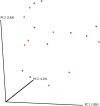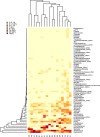Severity-related changes of bronchial microbiome in chronic obstructive pulmonary disease
- PMID: 25253795
- PMCID: PMC4313290
- DOI: 10.1128/JCM.01967-14
Severity-related changes of bronchial microbiome in chronic obstructive pulmonary disease
Abstract
Bronchial colonization by potentially pathogenic microorganisms (PPMs) is often demonstrated in chronic obstructive pulmonary disease (COPD), but culture-based techniques identify only a portion of the bacteria in mucosal surfaces. The aim of the study was to determine changes in the bronchial microbiome of COPD associated with the severity of the disease. The bronchial microbiome of COPD patients was analyzed by 16S rRNA gene amplification and pyrosequencing in sputum samples obtained during stable disease. Seventeen COPD patients were studied (forced expiratory volume in the first second expressed as a percentage of the forced vital capacity [FEV1%] median, 35.0%; interquartile range [IQR], 31.5 to 52.0), providing a mean of 4,493 (standard deviation [SD], 2,598) sequences corresponding to 47 operational taxonomic units (OTUs) (SD, 17) at a 97% identity level. Patients were dichotomized according to their lung function as moderate to severe when their FEV1% values were over the median and as advanced when FEV1% values were lower. The most prevalent phyla in sputum were Proteobacteria (44%) and Firmicutes (16%), followed by Actinobacteria (13%). A greater microbial diversity was found in patients with moderate-to-severe disease, and alpha diversity showed a statistically significant decrease in patients with advanced disease when assessed by Shannon (ρ = 0.528; P = 0.029, Spearman correlation coefficient) and Chao1 (ρ = 0.53; P = 0.028, Spearman correlation coefficient) alpha-diversity indexes. The higher severity that characterizes advanced COPD is paralleled by a decrease in the diversity of the bronchial microbiome, with a loss of part of the resident flora that is replaced by a more restricted microbiota that includes PPMs.
Copyright © 2014, American Society for Microbiology. All Rights Reserved.
Figures






Comment in
-
Chronic obstructive pulmonary disease lung microbiota diversity may be mediated by age or inhaled corticosteroid use.J Clin Microbiol. 2015 Mar;53(3):1050. doi: 10.1128/JCM.03320-14. J Clin Microbiol. 2015. PMID: 25700526 Free PMC article. No abstract available.
-
Reply to "chronic obstructive pulmonary disease lung microbiota diversity may be mediated by age or inhaled corticosteroid use".J Clin Microbiol. 2015 Mar;53(3):1051. doi: 10.1128/JCM.03358-14. J Clin Microbiol. 2015. PMID: 25700527 Free PMC article. No abstract available.
References
-
- Han MK, Huang YJ, Lipuma JJ, Boushey HA, Boucher RC, Cookson WO, Curtis JL, Erb-Downward J, Lynch SV, Sethi S, Toews GB, Young VB, Wolfgang MC, Huffnagle GB, Martinez FJ. 2012. Significance of the microbiome in obstructive lung disease. Thorax 67:456–463. 10.1136/thoraxjnl-2011-201183. - DOI - PMC - PubMed
Publication types
MeSH terms
Substances
LinkOut - more resources
Full Text Sources
Other Literature Sources
Medical

